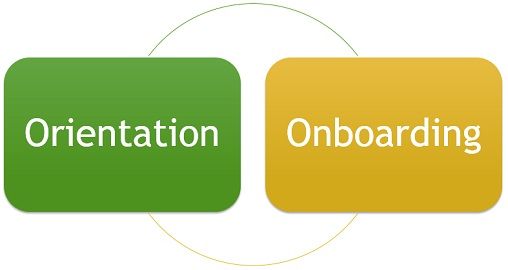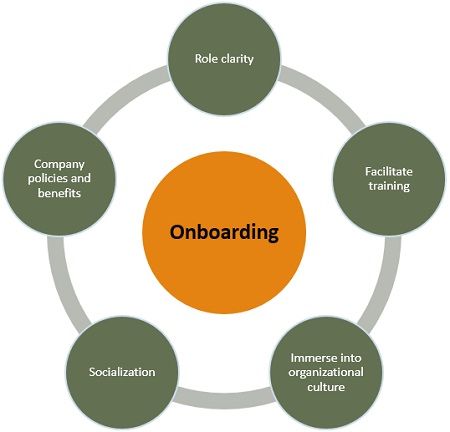 A warm and positive welcome of a newly joined employee is not just a good start for him/her, but it also ensures that they work for the company with energy, enthusiasm, loyalty and commitment for a long term. The company holds an orientation programme in order to inform the new joinee about the company’s fundamental details about its mission, vision, objectives, policies, etc.
A warm and positive welcome of a newly joined employee is not just a good start for him/her, but it also ensures that they work for the company with energy, enthusiasm, loyalty and commitment for a long term. The company holds an orientation programme in order to inform the new joinee about the company’s fundamental details about its mission, vision, objectives, policies, etc.
On the contrary, in the case of onboarding, the employee gets to know about his/her role in the company and all other details which are relevant to the job or position are also provided.
An orientation involves formal training in which the new joinee has to present in-person. As against, onboarding involves both formal and informal training, directing, socialization etc. The basic difference between orientation and onboarding lies in the fact that orientation is the first step to onboarding.
Content: Orientation Vs Onboarding
Comparison Chart
| Basis for Comparison | Orientation | Onboarding |
|---|---|---|
| Meaning | Orientation is a well-formulated introduction of the new joinees to the jobs, peers and the organization. | Onboarding is a strategic process of immersing the new joinee into the organization and its culture. |
| What is it? | Event | Process |
| Lasts up to | Few days | One to three months or sometimes a year |
| Communication | One-way | Two-way |
| Involves | Formal Introduction of the organization | Comprehensive Introduction of the organization and its operations. |
| Location | Classroom or online | Workplace |
| Carried out | In groups | Specifically for each and every individual |
| Information provided | Need-to-know information is provided. | Customized information as per the role is provided. |
| Result | The new hire will be ready for training. | The new hire will be ready to contribute. |
| Objective | To provide the new joinee with the essential tools and basic information which are needed to carry out the job. | To assimilate the new joinee into the organizational culture. |
Definition of Orientation
An orientation programme is one in which the freshly appointed employees are officially introduced to the organization, i.e. the workplace and its culture, mission, vision, objectives, and values. It is held to provide all such information relating to the companies policies, job roles, responsibilities, etc. which he/she needs to work satisfactorily in the company.
In general, orientation is conducted on the very first day or week of the joining, in a conference type event, wherein all the newly appointed employees of various department are brought together, and necessary information is provided in the form of presentation. It provides the following information:
- Basic information about the day to day work.
- Overview of the firm’s history, founders, etc.
- Mission, Vision, Objectives, Operations, Offerings, etc.
- Employee’s health and safety, company policies, compensation and benefits, attendance and leaves.
Orientation is performed to help the employee in understanding the expectations of the firm, make him comfortable in the job/department/team, gain the employee commitment, remove the anxiety and confusion, encourage open communication, etc.
Definition of Onboarding
In an onboarding, the employee is exhaustively acquainted with their concerned department and its functions. It is a strategic process which is concerned with assisting the new hire in transition with the new environment. It is a crucial element to the talent acquisition, development and retention strategy of the firm.
It is customized as per the needs of the individual employee, i.e. his/her role, training, mentoring and employee engagement. During the process, the employee learns what is expected from him, concerning the skills, communication, abilities and attitude.
Onboarding uses various tactics like a formal meeting, printed materials, orientation (online/offline), video conferences, lectures, and so forth. It tends to communicate the brand and values, professional culture, orient the expectation and performance, describe your target audience, etc.
Further, it also involves completion of the required documentation concerning the labour law compliance and providing them with the necessary tools so that they can work effectively. It is aimed at increasing the level of commitment, satisfaction and performance in employees while decreasing the labour turnover.
An effective onboarding lasts up to one year or so, which covers continuous communication, feedback, and performance measurement of the employees.
Key Differences Between Orientation and Onboarding
The differences between orientation and onboarding can be drawn clearly on the following grounds:
- Orientation means to introduce and guide the new employee, so as to help him/her in adjusting to the new environment, workplace, activity, and so on. On the flip side, onboarding can be defined as the strategic process which helps the new employees in gathering the essential skills, attitude, knowledge, behaviour and expertise, to become a committed and competent member or insider of the firm.
- Orientation is a one-time event, whereas onboarding is an ongoing process.
- Ideally, an orientation continues upto several days, but onboarding continues for a few months.
- Orientation is a one-way process presided over by the companies executives who provide the basics of the company. Conversely, onboarding is a two-way communication which covers multiple sessions, by various departmental heads. In this process, questions and experiences of the incumbent overtime, are welcomed.
- In orientation, the employee gets to know about the company’s guidelines, rules, policies, procedures, and other important information, which all the employees must know. As against, In an onboarding, the employee is familiarized with job/position-related information from the manager, supervisor, colleagues and subordinates.
- When it comes to location, orientation is conducted in a classroom or conference setting and even online. However, onboarding is conducted at the workplace, and that too when the employee is on-the-job.
- Orientation is conducted in groups, which means that all the new joinees are brought together and the programme is convened in a conference style. In contrast, onboarding is tailored specifically for the particular employee and his/her role.
- Orientation provides all the need-to-know information to the employees, as well as it supervises the employees about practical needs such as computers, systems, security access, etc. In onboarding, customized information is provided o the new joinee.
- After orientation, the new hire will be ready to undergo training at the workplace, whereas after onboarding, the new hire will be all set to contribute effectively.
- The objective behind orientation is to supply the new joinee with the essential tools and fundamental information which are required to perform the job. As opposed, onboarding aims at assimilating the new joinee into the organizational culture.
Conclusion
It has been observed that a well-planned orientation and onboarding helps the incumbent in knowing their role and responsibility and adjusting to the work environment effectively.
In orientation, the employee learns about his/her role in the organization. Contrastingly, in onboarding, the employee gets to know about his/her role in the respective department.






Leave a Reply